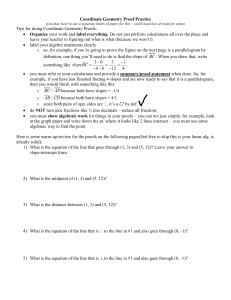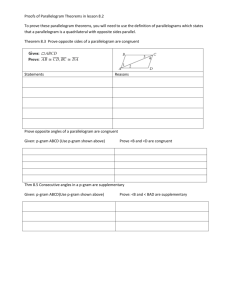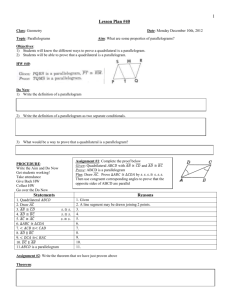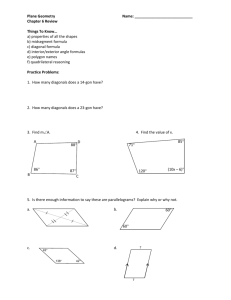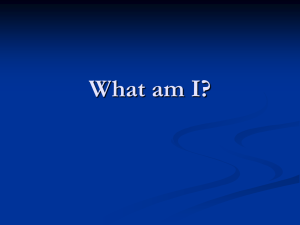Quadrilateral Proofs: Parallelograms, Rhombuses, Trapezoids
advertisement
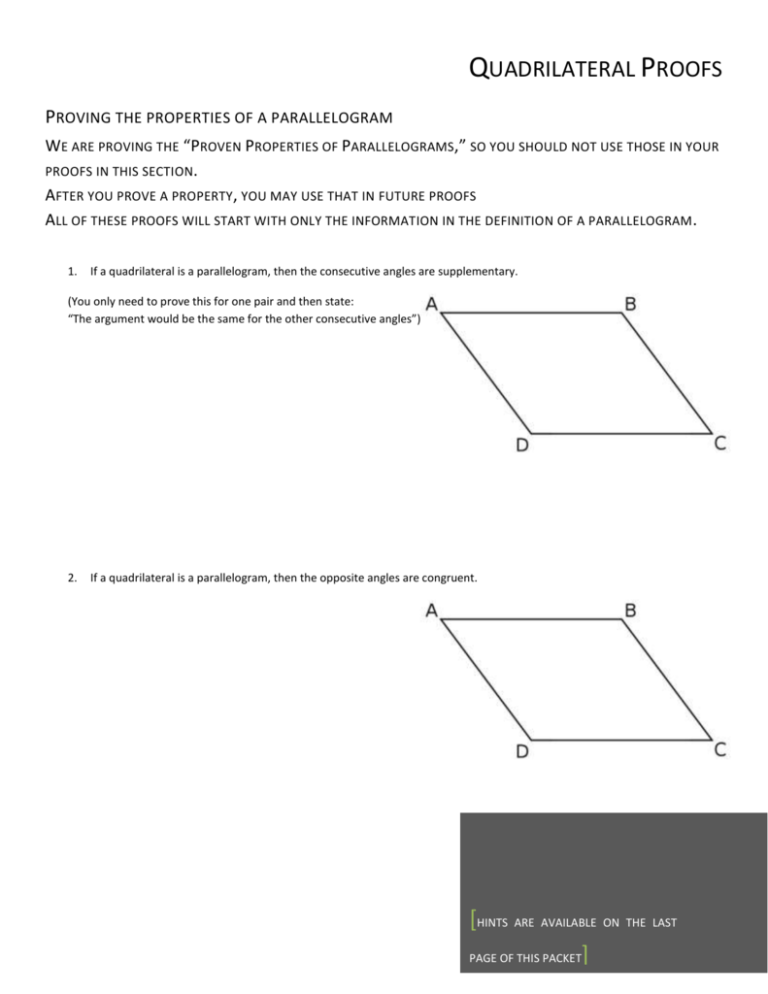
QUADRILATERAL PROOFS PROVING THE PROPERTIES OF A PARALLELOGRAM WE ARE PROVING THE “PROVEN PROPERTIES OF PARALLELOGRAMS,” SO YOU SHOULD NOT USE THOSE IN YOUR PROOFS IN THIS SECTION. AFTER YOU PROVE A PROPERTY, YOU MAY USE THAT IN FUTURE PROOFS ALL OF THESE PROOFS WILL START WITH ONLY THE INFORMATION IN THE DEFINITION OF A PARALLELOGRAM . 1. If a quadrilateral is a parallelogram, then the consecutive angles are supplementary. (You only need to prove this for one pair and then state: “The argument would be the same for the other consecutive angles”) 2. If a quadrilateral is a parallelogram, then the opposite angles are congruent. [HINTS ARE AVAILABLE ON THE LAST PAGE OF THIS PACKET] 3. If a quadrilateral is a parallelogram, then the opposite sides are congruent. 4. If a quadrilateral is a parallelogram, then the diagonals bisect each other. (You will need to use the proven property from #3) NOW THAT YOU HAVE PROVEN THESE, YOU CAN USE THESE PROPERTIES IN ANY QUADRILATERAL THAT IS ALSO A PARALLELOGRAM (RHOMBUS, RECTANGLE, OR SQUARE.) PROVING THAT A QUADRILATERAL IS A PARALLELOGRAM TO PROVE SOMETHING IS A PARALLELOGRAM , WE NEED TO MATCH THE DEFINITION: A PARALLELOGRAM HAS 2 PAIRS OF OPPOSITE SIDES PARALLEL . WE ARE PROVING THE “SUFFICIENT CONDITIONS OF PARALLELOGRAMS,” SO YOU SHOULD NOT USE THOSE IN YOUR PROOFS IN THIS SECTION. HOW DO WE PROVE LINES ARE PARALLEL ? TRY TO FIND AIA, SSIA, OR CORRESPONDING ANGLES. 1. If the opposite sides are congruent, then the quadrilateral is a parallelogram. 2. If the opposite angles are congruent, then the quadrilateral is a parallelogram. 3. If one pair of opposite sides is both parallel and congruent, then the quadrilateral is a parallelogram. 4. If the diagonals bisect each other, then the quadrilateral is a parallelogram. OTHER QUADRILATERAL PROOFS: NONE OF THESE PROOFS ARE 1 STEP. IF THE PROOF IS A THEOREM , THEN YOU ARE PROVING THAT THEOREM; DO NOT USE IT IN YOUR PROOF. 1. Prove the diagonals of an isosceles trapezoid are congruent. 2. Prove that the line through the ends of a kite is a line of symmetry. (This is a proof of the Kite Symmetry Theorem, so don’t use that.) 3. Prove that the perpendicular bisector of the bases of an isosceles trapezoid is a line of symmetry. (This is a proof of the Isosceles Trapezoid Symmetry Theorem, so don’t use that.) 4. Prove that the diagonal through the ends of a kite is a perpendicular bisector of the other diagonal. (This is a proof of the Kite Diagonal Theorem, so don’t use that.) 5. Prove that a trapezoid with one right angle must have another right angle. 6. Prove that a paralleogram with one right angle is a rectangle. 7. Prove the diagonals of a rectangle are congruent. 8. Prove that the diagonals of a rhombus bisect the vertex angle. (This is a proof of the Rhombus Diagonal Theorem, so don’t use that.) CHALLENGE: THESE PROOFS ARE MORE CHALLENGING AND WILL BE WORTH SOME EXTRA CREDIT. THERE ARE NO HINTS FOR THESE PROOFS . 9. Prove the diagonals of a rhombus are perpendicular bisectors of each other. 10. Prove the diagonals of a square are both congruent and also perpendicular bisectors of each other. HINTS PROVING THE PROPERTIES OF A PARALLELOGRAM 1. 2. 3. 4. SSIA Draw a diagonal and prove 2 congruent triangles Draw a diagonal and prove 2 congruent triangles Find a congruent triangle pair PROVING THAT A QUADRILATERAL IS A PARALLELOGRAM 1. 2. 3. 4. Draw a diagonal and prove 2 congruent triangles Make the opposite angles equal with variables. What do all 4 angles add up to? Draw a diagonal and prove 2 congruent triangles Draw both diagonals and prove 2 congruent triangles OTHER QUADRILATERAL PROOFS: 1. 2. 3. 4. 5. 6. 7. 8. Overlapping congruent triangles Use triangle congruence to show reflection -or- Use perpendicular bisector theorem to show a perpendicular bisector. See symmetry proofs Perpendicular Bisector Theorem SSIA + 90 SSIA + 90 Overlapping congruent triangles AIA + ITBAT
